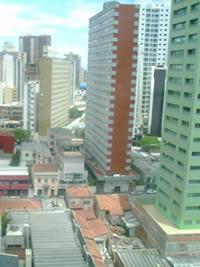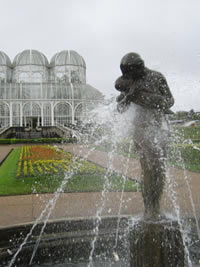Curitiba is the capital city of the Brazilian state of Paraná, the largest financial center in southern Brazil. A theory about the name "Curitiba" comes from the Tupi words kurí tyba, "many pine" due to the large number of Brazilian Pines.
Curitiba officially became a town around 1812, spelling its name as Curityba. An alternative spelling also came up: Coritiba. This spelling looked to become dominant for it was used in press and state documents, but a state decree in 1919 settled the dispute by spelling the city name Curitiba.
Curitiba has a very simple and practical transportation system. Public transportation consists entirely of buses. There are several different types of buses, each with a different function. Moving around in a car can be difficult in and around the city centre because of the many one-way streets and frequent traffic jams. This makes the public transportation system more attractive if one wants to go there.
Curitiba has a master planned transportation system, which includes lanes on major streets devoted to a bus rapid transit system. The buses are long, split into three sections, and stop at designated elevated tubes, complete with disabled access. There is only one price no matter how far you travel and you pay at the bus stop. The system, used by 85% of Curitiba's population.
As far as toursim, there are several options. Three of many options are Botanic Garden, Ópera de Arame, and the Oscar Niemeyer Museum
Botanic Gardens - Curitiba’s trademark, created to resemble French gardens, rolls out its flower carpet to the visitors right at the entrance. The greenhouse, with a metallic structure, has botanic species that are national reference, and also a water fountain.
Ópera de Arame - A wire opera house. It is one of the major tourist attractions of the city. The Wire Opera House theatre is built out of steel tubes, which gave it its name. Situated in the middle of the Pedreiras Park, it caters to all types of shows, between lakes, typical vegetation and cascades, on a unique landscape.
Oscar Niemeyer Museum - The museum focuses on the visual arts, architecture and design. For its magnificence, beauty and for the importance of the collection, it represents a cultural institution of international significance. The complex is a true example of architecture allied with art. The museum was initially designed by Oscar Niemeyer, faithful to the style of the time, and conceived as an educational institute. Later it was remodeled and adapted to function as a museum, for which Niemeyer designed the annex, reminiscent of an eye, imprinting it with a new characteristic identity. The museum features many of Niemeyer's signature elements: bold geometric forms, sculptural curved volumes placed prominently to contrast with rectangular volumes, sinuous ramps for pedestrians, large areas of white painted concrete, and areas with vivid murals or paintings.
(Courtesy of Wikipedia)



